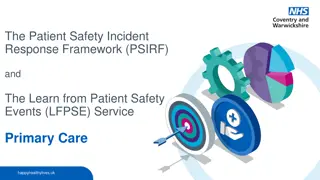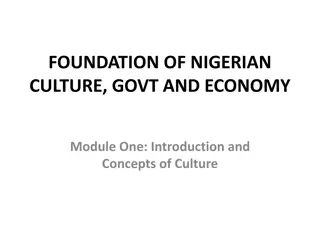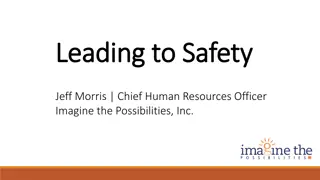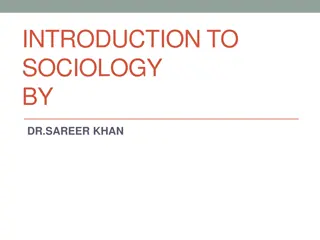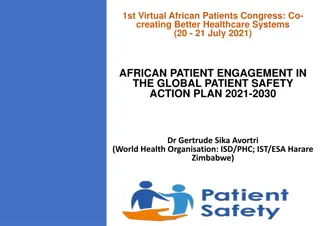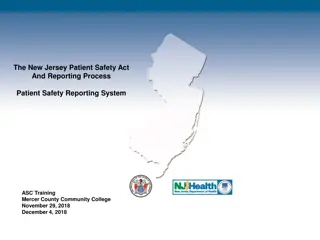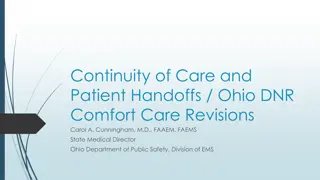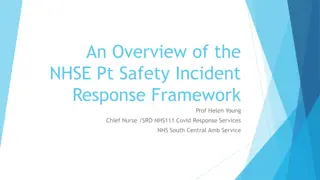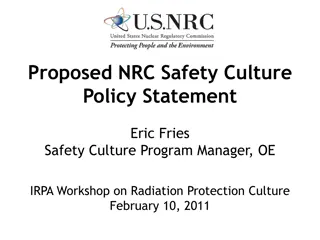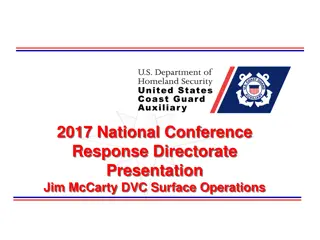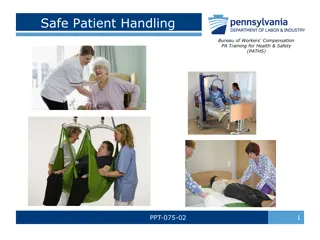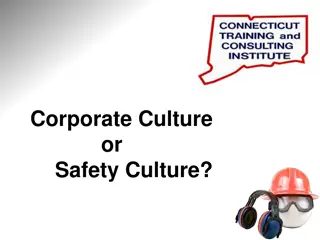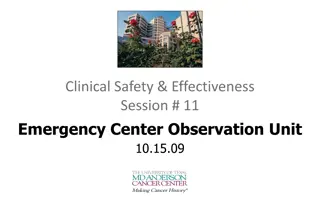Understanding Patient Safety Culture and Its Key Characteristics
Patient Safety Culture is vital in healthcare organizations as it involves individual and group values, attitudes, and behaviors that influence safety commitment and management. The chapter delves into theories and approaches to fostering a safety-based culture locally, highlighting the importance of mutual trust, shared perceptions on safety, and confidence in preventive measures. Resources and models like MaPSaf and the Swiss Cheese Model are discussed in relation to promoting safety culture for sustainable improvement.
- Patient Safety Culture
- Healthcare Management
- Safety Culture Theories
- Organizational Safety
- Preventive Measures
Download Presentation

Please find below an Image/Link to download the presentation.
The content on the website is provided AS IS for your information and personal use only. It may not be sold, licensed, or shared on other websites without obtaining consent from the author. Download presentation by click this link. If you encounter any issues during the download, it is possible that the publisher has removed the file from their server.
E N D
Presentation Transcript
Chapter 2 Patient Safety Culture @SAFE_QI
Chapter 2: Theories of Patient Safety To create sustainable improvements in safety, it is necessary to create a culture of safety. This chapter introduced the key theories and approaches to developing a safety-based culture locally. @SAFE_QI
Why is safety culture? The safety culture of an organisation is the product of individual and group values, attitudes, perceptions, competencies and patterns of behaviour that determine the commitment to, and the style and proficiency of, an organisation s health and safety management. @SAFE_QI
What is safety culture Culture is learned, not biologically inherited What we produce = the outcomes What we think What we do All based on our mental processes, beliefs, knowledge, and values @SAFE_QI Adapted from Reason
WHAT WE PERMIT WE PROMOTE @SAFE_QI
Key characteristics of safety culture Mutual trust Shared perceptions on the importance of safety Safety culture Confidence in the efficacy of preventive measures @SAFE_QI
Resources Manchester Patient Safety Scales (MaPSaf) Sexton Safety Attitudes Survey Experience of Care Survey SHINE Tool @SAFE_QI
The Model for Safety Culture No time for safety or investment into improvement Pathological Reactive Safety occurs in response to an incident Safety is driven by management systems and imposed on the workforce Bureaucratic There is value placed in safety with continually improving systems Proactive The ideal, where safety is an integral part of everyday life in all staff Generative @SAFE_QI Hudson P. Applying the lessons of high risk industries to health care Qual Saf Health Care 2003
Swiss Cheese Model @SAFE_QI Reference James Reason
Where is healthcare? We embrace procedures http://www.animatedknots.com/photos/shoelacefieggen/shoelacefieggenR10.jpg Self-reflection is encouraged Safety tends to come from management @SAFE_QI
Where is healthcare cont. Generative Proactive Increasing informedness Bureaucratic Increasing trust Reactive Pathological @SAFE_QI Hudson P. Applying the lessons of high risk industries to health care Qual Saf Health Care 2003
How can we mature into a proactive organisation? Reporting Safety Management Systems Investigation Attitudes @SAFE_QI
How can we map progress? Manchester Patient Safety Framework (MaPSaF) Facilitate reflection on patient safety culture Stimulate discussion about the strengths and weaknesses of the patient safety culture Reveal any differences in perceptions between staff groups Help understand how a more mature safety culture might look Help evaluate any specific intervention needed to change the patient safety culture @SAFE_QI www.nrls.npsa.nhs.uk Home Patient safety resources
Foundation for safety A safety policy A feedback loop to improve safety performance Organisational arrangements to support safety A means of measuring safety performance A safety plan @SAFE_QI
A framework for the measurement and monitoring of safety Past Harm Integration and learning Reliability Past harm Anticipation and preparedness Sensitivity to operations @SAFE_QISource: Vincent C, Burnett S, Carthey J. The measurement and monitoring of safety. The Health Foundation, 2013. www.health.org.uk/publications/the-measurement-and-monitoring-of-safety
Moving from Risk Management to Safety 1 Safety 1 Risk management Measurement of quality and harm continually Compliance with standards Trigger tool Daily measures Complete Partial None Risk Registers Measurement for improvement Run charts & SPC Improvement methodology Current? Meaningful? Acted upon? Responding to complaints Small scale test of change PDSA Strategic Alignment Driver diagrams Process changes Timely Remedial action Incident reporting and Investigations Human Factors understanding Communication e.g. SBAR Situational Awareness Design changes Incident trees Serious case reviews RCA @SAFE_QI NHS III
Moving from Safety 1 to Safety 2 Things that Early completion Are difficult but go right Excellent innovation Things that go wrong Positive surprises Unwanted Outcome Planned Great outcome Hollnagel E., Wears R.L. and Braithwaite J. From Safety-I to Safety-II: A White Paper. The Resilient Health Care Net @SAFE_QI
The huddle suite: Achieving situation awareness Escalate Leaders Daily Safety Brief Overview of events of harm and risk Mitigate Ward Safety Huddle Nurses, Doctors, Allied professionals PEWS, Watchers, family or communication concern Identify Ward Bedside huddles Nurse Doctor Parent @SAFE_QI
Reliable Communication I-S-B-A-R Identify Situation Background Assessment Recommendation and Read back @SAFE_QI
Ten suggestions for harm-free paediatrics Fitzsimons J and Vaughan D Patient Safety (P Lachman, Section Editor) Current Treatment Options in Pediatrics December 2015, Volume 1, Issue 4, pp 275-285 1. No or minimal pain and distress 2. No tissue injury extravasation, pressure ulcer or other tissue injury 3. No hospital-acquired infections 4. No medication or fluid injuries 5. Early recognition and management of procedural or surgical complications 6. Early recognition and management of sepsis or other life-threatening illnesses 7. Early recognition and management of in-hospital deterioration 8. Early recognition and management of safeguarding concerns 9. No unnecessary admissions, investigations, procedures or treatments 10. No psychological harm provide a positive experience @SAFE_QI
Daily questions to ask at all levels What did we do well? So we can replicate Past harm Has patient care been safe in the past? Reliability Are our clinical systems and processes reliable Sensitivity to operations Is care safe today? Anticipation and preparedness Will care be safe in the future? Integration and learning Are we responding and improving? @SAFE_QI





